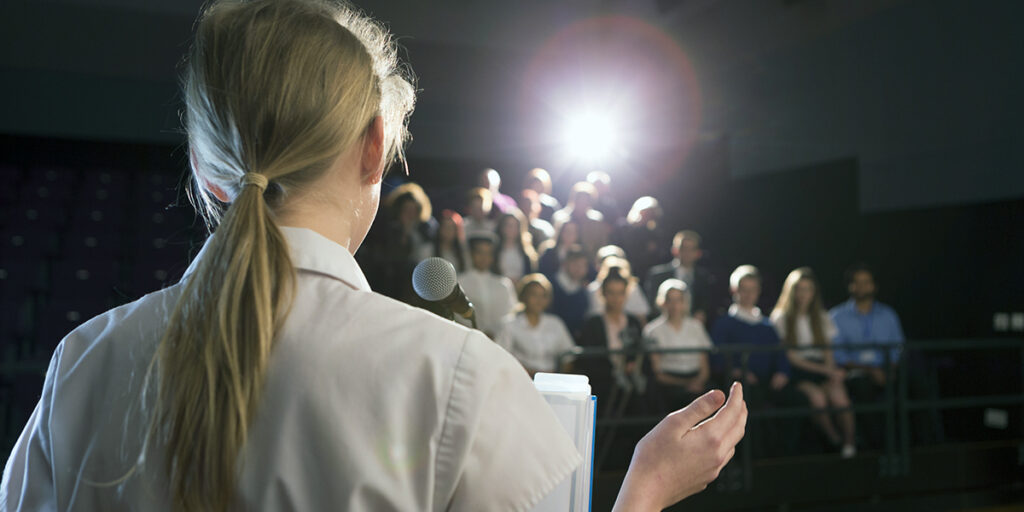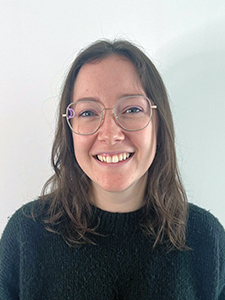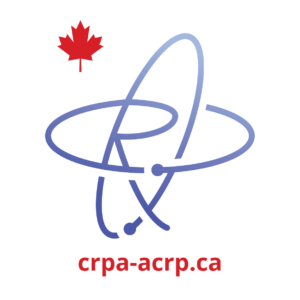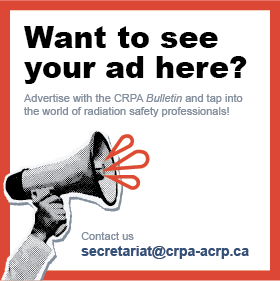2025 Anthony J. MacKay Student Paper Contest: Meet This Year’s Finalists

Each year, the Student and Young Professionals Committee organizes a student paper contest in conjunction with the CRPA annual conference. This contest is open to all students enrolled full-time in a Canadian college or university program related to the radiation sciences.
Entrants must submit an abstract of no more than 750 words on a topic that is related to some aspect of radiation; the topic is intentionally kept broad to encourage participation from a wide range of students.
Three finalists are selected to present their work at the conference in a plenary session. Conference registration (including the banquet) and three nights hotel accommodation are provided for all three finalists.
The presentations are judged at the end of the session, and the winner is announced during the awards banquet. The winner is presented with the Anthony J. MacKay trophy and receives a $250 cash prize.
All students who enter the contest are given a free one-year membership to the CRPA.
Meet this year’s finalists!
Amir Jabbarpour
Carleton University
A newcomer to Canada, Amir moved here three years ago to begin his PhD in medical physics at Carleton University and the Ottawa Hospital Research Institute.
He learned about radiotherapy while studying physics in his undergraduate program and was intrigued by the idea of combining medicine and physics. Amir completed a master’s degree in medical physics using AI for radiotherapy. He now works largely with nuclear medicine.
When he is not working, Amir enjoys cooking, running, and photography. He will even be running a marathon in Ottawa the day before the conference!
Tell us a little about yourself.
I am doing my PhD in medical physics at Carleton University and the Ottawa Hospital Research Institute. I am a newcomer to Canada; I moved here three years ago to start my PhD.
I began studying physics in my undergraduate program, then eventually learned about radiotherapy and thought it was cool to use medicine and physics together. I completed my master’s degree in medical physics using AI for radiotherapy. Now, I am working more on the nuclear medicine side, but I have loved both.
When I am not working, I love cooking, running, and photography. Fun fact: I will be running in a marathon in Ottawa the day before the conference!
Share some background on your submitted work.
Lung ventilation/perfusion scintigraphy allows us to image patients to see where blood vessels or air passages are blocked, and these images are used to diagnose pulmonary embolism. We are proposing an AI algorithm that enhances the quality of images acquired over shorter periods of time, reducing dose to patients.
This project has been quite challenging, and the work submitted to the student paper contest is just one part of it. There are a lot of hidden complexities, and, for a long time, I felt completely stuck. However, just a few weeks before the contest deadline, things started to work out!
How did you hear about the Anthony J. MacKay Student Paper Contest?
My supervisor is a medical physicist at the Ottawa Hospital, and the student paper contest notice was being shared in the hospital network. My supervisor recommended I go for it.
What are you looking forward to most at the conference?
I have attended other conferences, but they were more international and not specific to radiation protection. I am looking forward to learning from other researchers, making connections, and getting to know others in the field. I would also like to go running and hopefully explore Niagara Falls.
What’s up next for you?
We are developing another AI model to automatically diagnose pulmonary embolism and highlight ventilation/perfusion (V/Q) mismatches,1 and we are looking to combine these two AIs.
Furthermore, we aim to project the AI-segmented defect into the segmental lung lobe anatomical atlas of a normal patient. We will use this information to quantify the function of lung lobes and analyze the survival chances for the suspected patients based on the size and location of the defect, as well as the percentage of compromised lung lobes. This quantification has another cool application in lung lobectomy surgery radiotherapies, which consider lung function and whether or not the lung can tolerate different therapies.
I want to become a medical physicist and will hopefully be applying for residency after graduation. I love being in the hospital, and I want to continue with research. I would love to support and supervise a student in the future.
Read Amir’s abstract: AI-Driven Enhancement of Low-Count Lung Scintigraphy: Optimizing Radiation Safety and Imaging Efficiency with cGANs
Minahil Manzoor
Ontario Tech University
Ontario Tech University student Minahil has completed the first year of her master’s degree in nuclear engineering with a focus on health physics. As a teaching assistant, she has enjoyed teaching and helping shape undergraduate courses.
Minahil earned her undergraduate degree in medical physics at Toronto Metropolitan University, where she was part of Women in Physics. She enjoyed having a dedicated space and getting to hear other women’s experiences.
After completing her undergraduate degree, Minahil took a year off to work in an optometry clinic, which ended up relating to her current research!
Tell us a little about yourself.
I am in the first year of my master’s degree in nuclear engineering with a focus on health physics. I have really enjoyed teaching and helping shape undergraduate courses as a teaching assistant.
I completed my undergraduate degree in medical physics at Toronto Metropolitan University, where I was part of Women in Physics. It was fun to hear other women’s experiences in the industry and have that dedicated space.
I took a year off after my undergrad and worked in an optometry clinic, which ended up relating to my current research!
Share some background on your submitted work.
After reaching out to Dr. Waller, I found the topic of eye dosimetry interesting, and I learned about the recent changes to regulatory limits. Many dosimeters currently are thermoluminescent dosimeters (TLDs), but optically stimulated luminescent dosimeters (OSLDs) are more sensitive and reusable. Hp(0.07) dosimeters are also often used as a surrogate for the preferred Hp(3) metric, as Hp(3) dosimeters are not as readily available. My work assessed the correlation between Hp(0.07) and Hp(3) and how to convert Hp(0.07) to Hp(3) using a conversion factor or phantom. I evaluated the use of nanodot OSLDs and made an annealer, trying different LED lights and comparing how they affected the OSLDs sensitivity. It was challenging at times, especially during the first few months, but it has been fun!
How did you hear about the Anthony J. MacKay Student Paper Contest?
In the past, I have seen it promoted on LinkedIn. This year, my supervisor, Ed Waller, encouraged me to join CPRA and enter the contest.
What are you looking forward to most at the conference?
I am looking forward to meeting the people I have been emailing with, meeting more CPRA members, and presenting my work. While I am in Hamilton, I will be visiting McMaster and some of the restaurants. I will also be checking out antique malls and thrift stores, as I love thrifting!
What’s up next for you?
I would like to become a health physicist or radiation safety officer. I am also interested in policy-making and being a part of decision-making processes.
In the future, I may complete a doctorate, but going into industry would also be very interesting. One of the most encouraging things I have learned from my professors is to try new things. I firmly believe that you are never too old to learn!
Read Minahil’s abstract: Enhancing Eye Dose Monitoring in Radiation Protection: Evaluating Hp(0.07) and OSLDs as an Alternative to Hp(3)
Olivia Sharp
University of Toronto
Olivia is currently finishing the second year of coursework in the Medical Radiation Science, Nuclear Medicine and Molecular Imaging Technology program through the University of Toronto and The Michener Institute of Education at University Health Network (UHN). When Olivia started at UHN, radiation safety was new to her, but she has greatly enjoyed spending the last year learning more about it and working in the Radiation Safety Office.
Olivia typically has her nose in a book, either to study or for pleasure! She also enjoys sports, particularly rugby and yoga.
Tell us a little about yourself.
I am finishing my second year of coursework in the Medical Radiation Science, Nuclear Medicine and Molecular Imaging Technology program through the University of Toronto and The Michener Institute of Education at University Health Network (UHN). When I was hired at UHN, I was asked to pick what I was interested in from a list of topics, and I chose radiation safety. Radiation safety was new to me, but I have spent the past year getting to know more about it and working in the Radiation Safety Office, which has been incredible.
I generally have my nose in a book, whether that is a textbook or a book I am reading for enjoyment. I just finished The Blind Assassin by Margaret Atwood, which was great. I also really love sports; I played rugby growing up and I do yoga.
Share some background on your submitted work.
This work was specific to nuclear medicine workers, which is what I will be working as in the future. It was an assessment to evaluate if whole body dosimeters were reliably capturing eye doses for nuclear medicine and PET workers at UHN. We attached tiny dosimeters to the safety glasses or masks of the workers to compare with the results from their whole-body dosimeters.
I am excited to see this paper come together, and I appreciate all the technologists who donated their time and wore the extra dosimeters. I am grateful to have the opportunity to share this work and the knowledge I have gained!
How did you hear about the Anthony J. MacKay Student Paper Contest?
Multiple people from the Radiation Safety Department reached out to me suggesting I enter the contest. Michener also reached out to all their students to encourage them to submit their work.
What are you looking forward to most at the conference?
I am excited to see what the other students have submitted and to see the other talks on topics and areas I have not had as much experience with. I think the banquet and just meeting new people will be highlights. I am also excited to try the restaurants, as well as some of the hikes and waterfall trails nearby!
What’s up next for you?
This spring, I will be starting a full-time, one-year placement at Oakville Memorial Trafalgar Hospital. After finishing my placement, I will be writing the exam to become a licensed medical radiation technologist. I am looking forward to learning more about how I can apply what I have learned to my career as a technologist. I may end up working at a small clinic, which would generally have a technologist as the radiation safety officer. I know this won’t be the end of radiation safety for me!
Read Olivia’s abstract: Lens of Eye Dose Assessment for Nuclear Medicine and PET Technologists
Do you want to read more articles like this?
The Bulletin is published by the Canadian Radiation Protection Association (CRPA). It’s a must-read publication for radiation protection professionals in Canada. The editorial content delivers the insights, information, advice, and valuable solutions that radiation protection professionals need to stay at the forefront of their profession.
Sign up today and we’ll send you an email each time a new edition goes live. In between issues, check back often for updates and new articles.
Don’t miss an issue. Subscribe now!






